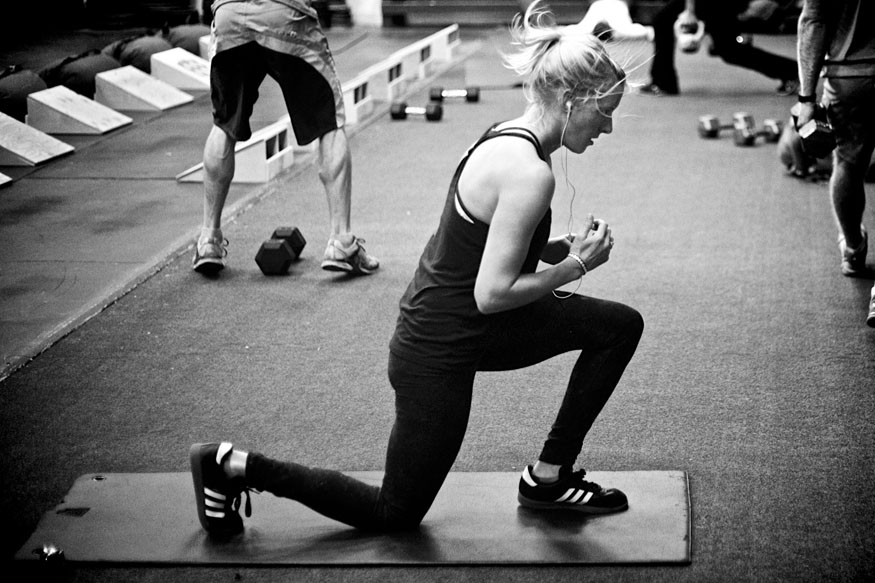
By Rob Shaul
Necessity is the mother of invention, and several years ago MTI had a relationship with The North Face (TNF).
TNF was introducing a training line of apparel and partnered with us and others to promote it. Our job was the programming.
One of TNF’s other partners was a nonprofit out of Chicago, which ran weekday, early morning, hour-long training sessions open to anyone in empty sports stadiums. TNF flew a couple dozen of this nonprofit’s exercise group leaders to Wyoming, where I taught them a 2-day programming course.
From a programming perspective, this was a challenging assignment. I needed to design deployable bodyweight strength programming components for athletes of all incoming fitness levels and with prior fitness assessments.
Because 100+ people would be training concurrently, I couldn’t use much, if any, equipment and needed to keep the components moving. And each component needed to automatically “scaleable” – so it could challenge and push extremely fit athletes, but also be within reach of deconditioned athletes.
Finally, the event needed to train the total body – upper and lower body.
One of the components I designed for that programming course, and still use today, I named “Bodyweight Flow.”
Bodyweight Flow Circuit Design has these characteristics:
- Exercises that train both lower and upper body
- 2-3 exercises per body part
- Up to 3 “groups” of exercises per circuit
- Choreographed circuits so the athlete could “flow” uninterrupted from exercise to exercise and from one group of exercises to the other
- Low reps per exercise to minimize stoppage for strength, and be accomplishable by less-fit athletes
- Time, not rep our round-based, so more fit athletes could move faster through rounds of the circuits, and thus do more work as needed to challenge their fitness
- Upper body press, and if pull up bars are available, upper body pull
Circuit Design
Classic Bodyweight Flow circuit design has 3 “groups” of exercises, with 2-3 exercises in each circuit, that “flow” naturally from one exercise to the next.
- Lower Body
- Upper Body Press
- Upper Body Pull
Reps are kept low … first because these circuits are more difficult than they appear, and second, so less fit athletes can complete them. Finally, the entire circuit is time, not round-based. This allows more fit athletes to move faster through the entire circuit and overall complete more work to challenge themselves. I like 20-minute “Grind” efforts. “Grind” = work steadily, not frantically, through the exercises in the circuit for the prescribed time. For example:
(1) 20 Minute Grind ….
- 1/3x Push Ups
- 1/3x Hand Release Push Ups
- 1/3x Clapping Push Ups,
- then …
- 1/2x Pull Up
- 1/2x Mixed Grip Pull-ups
- 1/2x Chin Ups,
- then …
- 3x In-Place Lunges
- 3x Walking Lunges
- 3x Jumping Lunges
Grind = work steadily, not frantically, through these circuits again and again for 20 minutes.
At MTI we generally train the mid-section or core separately, but there’s no reason a group of bodyweight core exercises couldn’t be added as well – especially if you add an extra five or so minutes to the duration. For example…
(1) 25 Minute Grind …
- 2/4x Hand Release Push Ups
- 4/4x Alligator Push Ups
- 2/4x Clapping Push Ups
- then…
- 1x Tarzan Pull Up
- 1/2x Chin Ups
- 1/2x Pull Up
- then …
- 6x Sit Ups
- 3x EOs
- 6x Face Down Back Extension
- then…
- 6x Squat
- 3x Squat Jump
- 3x Broad Jump
While the general rule is 3-4 groups of exercises, and 2-3 exercises per group, deploying total body, bodyweight exercises like the classic burpee and/or rope climb, allows you to change things up. Here’s an example.
(1) 20 Minute Grind …
- 6x Squat
- 3x Squat Jump
- 1/2x Push Up
- 1/2x Clapping Push Up
- 3x Burpee
- then …
- Rope Climb
Another example:
(1) 20 Minute Grind …
- 5x Bodyweight Rob Shauls
- 2/3x Jeremy Special
1x Rob Shaul = 2x Walking Lunges (4x steps total) + 2x Burpees
1x Jeremy Special = Pull Up + Ankles to Bar
When to Use Bodyweight Flow Circuits
Over the years, I’ve continued to deploy Bodyweight Flow circuits in many of our bodyweight and/or limited equipment training plans, as well in “base fitness” programming cycles where I want to give the athletes a break from heavy loading.
While these circuits are great for training bodyweight strength and strength endurance, each also carries a substantial work capacity effect. Myself and the other lab rats were always surprised at the cardio hit from these circuits … even at the “grind” pace.
Bodyweight Flow circuits also make great “on the fly” training events when you can’t make it to a gym, are stuck in a motel, or are on vacation. My only caution is to program fewer reps than you might think – the volume adds up fast. If you find yourself needed to stop and rest between exercises in one of the “groups” lower the rep count. Remember, the idea is to “flow” fluidly from exercise to exercise and from group to group for the entire prescribed time.
Finally, we’ve pushed the duration of these circuits to 30 minutes, but there’s no reason you couldn’t push them up to 60 minutes, and/or have one 20 minute circuit follow another. Be creative, and smart and flexible. If something is not working, change it on the fly.
Comments/Questions?
Email rob@mtntactical.com
You Might Also Like MTI’s Body Weight Flow Training Plan
